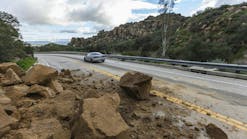
One of the things essential for enabling much of our current lifestyle—smartphones, laptops, electric cars—is actually a byproduct of long-ago erosion. In the Atacama Desert of Chile, what appears to be a giant salt flat actually represents about 20% of the world’s known supply of lithium, washed down from the Andes over many thousands of years.
As this article explains, lithium isn’t necessarily big business; worldwide, the sale of lithium salts accounts for about a billion dollars a year, small compared to many other commodities. But it’s an essential component of lithium batteries that we use in so many products.
One of the things essential for enabling much of our current lifestyle—smartphones, laptops, electric cars—is actually a byproduct of long-ago erosion. In the Atacama Desert of Chile, what appears to be a giant salt flat actually represents about 20% of the world’s known supply of lithium, washed down from the Andes over many thousands of years. As this article explains, lithium isn’t necessarily big business; worldwide, the sale of lithium salts accounts for about a billion dollars a year, small compared to many other commodities. But it’s an essential component of lithium batteries that we use in so many products. [text_ad] And as the article notes, demand is growing. Some car manufacturers are switching from heavier nickel-metal hydride batteries to lighter-weight lithium-ion batteries. Large-scale batteries that can store electricity from intermittent green energy sources, such as solar panels and wind turbines, are also expected to be in higher demand, both in private homes and for power utilities. Mining lithium is difficult and expensive, however, so although there seems to be plenty of it—Bolivia, Argentina, the US, China, and Australia also have significant deposits—rising demand does not necessarily mean that more countries are eager to supply more of it. Lithium mining has potentially severe environmental consequences, contaminating water and soil. Bolivia, believed to have some of the richest deposits in the world, has not yet taken steps to mine it on a large scale, possibly because of its experience with contamination and environmental degradation from the San Cristóbal mine, which produces silver, lead, and zinc and is located near the country’s lithium deposits.And as the article notes, demand is growing. Some car manufacturers are switching from heavier nickel-metal hydride batteries to lighter-weight lithium-ion batteries. Large-scale batteries that can store electricity from intermittent green energy sources, such as solar panels and wind turbines, are also expected to be in higher demand, both in private homes and for power utilities.
Mining lithium is difficult and expensive, however, so although there seems to be plenty of it—Bolivia, Argentina, the US, China, and Australia also have significant deposits—rising demand does not necessarily mean that more countries are eager to supply more of it. Lithium mining has potentially severe environmental consequences, contaminating water and soil. Bolivia, believed to have some of the richest deposits in the world, has not yet taken steps to mine it on a large scale, possibly because of its experience with contamination and environmental degradation from the San Cristóbal mine, which produces silver, lead, and zinc and is located near the country’s lithium deposits.Janice Kaspersen
Janice Kaspersen is the former editor of Erosion Control and Stormwater magazines.






